Astrology Readings
Only £99 for 90mins via Zoom
Fill in the Booking Form Here
For more information on Alison's readings or to see what people say about her click here
To watch a video trailer about the Astrology Reading Cards click on the image
WhatsApp Channels -
Astrology Chat and Cosmic Insights from Alison sent directly to you Whatsapp phone app. New for 2026.
CLICK HERE FOR THE WHATSAPP LINK
Starry Messengers
Alison's first book was a limited first edition and that has now sold out. But it was re-published as the `Future in the Stars` and there are still a few personally signed copies of this for sale.
See the `Publications For Sale` page
on this website

TThe Future in the Stars
See the Publications for Sale page
on this website to buy this
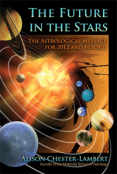
Click here to see review of
`Future in the Stars`
in Paradigm Shift
Click here to read a review of
`Future in the Stars`
on the RealAstrologers website
 MAKEMAKE, GREAT SEA SPIRIT OF EASTER ISLAND
The Meaning of the Dwarf Planet Named After Him
Easter Island's history gives us some of the greatest mysteries known. Why did they carve over 800 giant statues and how did they feed thousands of people on a little tiny island with no fresh water? Over the years `experts` have accused the beautiful and spiritual ancient Islanders of terrible acts of mindless ecocide. But they were all wrong. Makemake has come back to put this right and help us understand the REAL truth.
Makemake the Dwarf Planet
Possibly one of the biggest barriers to gaining public affection will be this planet`s name - people like to be able to pronounce a name confidently! But the name symbolises one of the biggest revolutions in astrology for centuries and those sort of shake-ups don`t come without a degree of hesitancy.
Early in the 21st century a big project to search for new planets began. It was headed by a maverick astronomer called Mike Brown and concentrated on the farthest known region of our solar system, the Kuiper Belt. Huge advancements in instrument technology had made this possible and the team were looking beyond Pluto in detail for the first time. The Kuiper belt is a donut shaped ring around the solar system and it contains thousands of objects from rocks to small planets.
One of the biggest events surrounding this project was the much publicised demotion of Pluto, as he was re-categorised a dwarf planet of the Kuiper Belt rather than the last member of the old solar system pantheon. The public responded to this announcement in the way that most people respond to Pluto; some celebrated the new potential, others felt real loss and went into mourning over it and others tried to cling to the old order and refused to acknowledge the change!
By the end of the project Mike Brown had re-written astronomy with the discovery of 4 new dwarf planets to add to the 2 or 3 we already had. But he also did something else; he broke centuries of strict tradition by naming the new planets after religions and mythology outside of the usual Greco-Roman choices. And in doing so he symbolised the biggest shift in religious and cultural dynasty since 3 astrologers rode into Jerusalem on camels and declared that a new star meant that a messiah had been born!
The names of two Polynesian deities were chosen and each introduces spiritual concepts that could not be accepted in the monotheism of the last 2,000 years, when a single god was worshipped. It is likely that this symbolises the close of a 2,000-year cycle and a return to spiritual understanding that reveres nature instead.
Creator God of Abundance, Competitivity and Fertility
Makemake was the chief creator god and Great Sea Spirit of Easter Island only; just 64 square miles of planet Earth. He was believed to be a deity of birth, sexuality and fertility so this choice was a natural one for Mike Brown who was filled with the joy and fecundity of his wife`s pregnancy at the time. It was also based on the planet`s discovery date which was Easter, exactly 283 years after the European discovery of this tiny, isolated island in the South Pacific Ocean.(1)
Easter Island is part of Polynesia, a race that lives on tiny islands of the vast Pacific Ocean. The Island is mid-way between the bulk of Polynesia and Chile, on the coast of South America. (You`d have to travel roughly 2,500 miles across the sea to reach either.) This mysterious little island, just 13 miles across is actually a huddle of 3 volcanoes that sit directly over a `hot spot` of a fault line in the earth`s crust and basically it could erupt or disappear at any moment.(2)
The indigenous people were wiped out by a European and Peruvian inspired holocaust in the 19th century. An entire population of tens of thousands died from European imported deadly diseases and the slave trade. Then missionaries arrived to `save` the remaining 150 Islanders, burning or destroying all the tablets inscribed with their ancient knowledge and condemning their pagan festivals and spiritual beliefs as wicked and evil.
There are contemporary writers who seek to use Easter Island as a metaphor for world ecological disaster by claiming that they savagely and mindlessly chopped down their last tree, but I think they are missing the point! Thankfully, since the discovery of Makemake the planet, this point of view is now being questioned by more recent evidence.(3)
These days, Easter Island is better known for what could NOT be destroyed and this has given us one of the biggest unsolved mysteries of our times. The island is covered in almost 800 giant stone statues (called mo`ai)
After carving, the statues were moved to stand on top of equally giant stone platforms around the coastline. These were actually catacombs and built to hold the bones of the ancestors whose surviving clan members then honoured their departed elders with the carving and naming of a giant statue to go on top. But why go to all these lengths?
Just as big a mystery is why they stopped producing them one day. Half of them were still being carved when one day the workers put down their picks and never went back!
And how or why did the standing ones all get knocked down again? Island myth talks of a ferocious storm(4) and the earliest reliable investigator, William Thompson, found evidence of earthquake.(5) Since an earthquake and tsunami destroyed coastal cities in Peru in 1746, this is entirely possible.(6) Any survivng statues may then have been toppled by revengeful or frightened rival clans who weren't going to allow another clan's ancestral images to remain standing.
Another unsolved mystery is a strange hieroglyphic writing that has been found on this tiny island only and nowhere else in the world. The royalty and ancient priesthood who understood it were all killed and missionaries destroyed most of it, although a handful of pieces survived. The Polynesians never developed a writing system so where did it come from?
Other unusual features of the island are thousands of ancient rock carvings and a yearly “Festival of the Seabird`s Eggs”. This was described to William Thomson by the few surviving Islander`s in 1886.(7)
The Origins of the Early Islanders
The ancient Polynesian navigators held mental maps of the rising and setting positions of stars and used sensitivity to nature, wind, sea currents and the sky to cross oceans on journeys of up to 4,000 miles. Seabirds would indicate nearby land or they would follow their migratory paths.(8) They travelled in large ocean-going double-hulled canoes that would hold people, animals, seeds and saplings, water and enough supplies for weeks at sea.(9)
Whilst it is thought that the early Easter Islanders were mainly Polynesian, the early North American Indians and South Americans were also crossing the oceans in the first millennium and there are some obvious influences on Easter Island, although academics argue this. However, since the Island is in the middle of all these cultures and they were all sea travellers, it would be strange if there weren`t some cross fertilisation.
A major piece of evidence is the sweet potato, which is indigenous to South America but made it`s way all over Polynesia, including Easter Island. Other irrefutable evidence is the D.N.A. from chicken bones found in Chile which dates to 1400AD and is the same as that found on other islands in the South Pacific.(10)
Also common to both cultures was the habit of lengthening and stretching the ear lobes, and the building of a certain style of huge wall out of massive tightly fitting stone blocks. The Islanders own name for their home meant `Navel at the Centre of the World` and this may have come from the Inca capital city in South America, which was also called `Navel of the Earth`.(11)
Each clan had a class system of farmers, fishermen, priesthood, and royalty which supported their own statue carver`s work. Some early contact reports said the island was flourishing and well farmed with Islanders who were robust, gregarious, good natured and inoffensive.
There was an east-west divide and tribal skirmishes occurred between the clans; mainly over women, honour and territory. Polynesians males in general regularly took part in war games and one-upmanship and on Easter Island in particular they enjoyed sporting competition such as javelin, netting and throwing.
The naturally naked and tattooed women of Easter Island were famous for their beauty, grace, seductive prowess and eroticism. Their attitude to sexuality was very different to ours - they understood it to be a pleasurable and truly creative act that celebrated fecundity and the abundance of life.
Makemake, The Winter Solstice and Working With Nature
Makemake is an aspect of nature that the Islander`s depended on for their survival. In that quadrant of the planet and on that small island, life was about rainfall, crops, seabirds and seafood. The Island had no fresh water supply, so they had to organize crop planting around the potential rainfall of the coming season. They were obviously very successful at this for the little Island supported a vast work force as evidenced by the amount of carved statues and rocks. William Thomson found many thousands of skeletons and numerous empty dwellings and he was mystified as to how so many could have been sustained without even a fresh water supply.
It was obvious from the Island rock art that Makemake`s patronage was most sort at a yearly major Island event called “The Festival of the Seabird`s Eggs”. (Called the `Birdman Competition` by subsequent authors.) This sporting event combined a test of courage, strength and stamina with a sacred knowledge that only the Island`s priesthood and royalty knew of. It centred on a knife-edge cliff between the sea and the crater of a volcano in a corner of the island called Orongo.
On the winter solstice (June 21st in the southern hemisphere), the rising Sun just happens to line up exactly with Orongo and the volcano at the other end of the island, giving them a natural `Stonehenge`.(12) The winter solstice is a very important spiritual occasion which marks the shortest day in the winter and therefore the beginning of the Sun`s return to power and strength; this symbolises re-birth and regeneration.
On Easter Island the winter solstice also marked the beginning of the season in which the treasured Sooty Tern
“According to the ancient custom, the fortunate individual who obtained possession of the first egg and returned with it unbroken to the expectant crowd, became entitled to certain privileges and rights during the following year…… it was supposed that he had won the approval of the great spirit Makemake.”
Okay, this all sounds like great fun, but something else happened on the winter solstice in that quadrant of the planet and the Island`s priesthood would have taken part in this sacred event also. And for this they needed a specific deity.
The Pleiades and the Possible Origins of Makemake.
Both the Easter Islanders and their neighbours the Peruvians, recognised the importance of a cluster of stars called the Pleiades, which used to rise before the Sun in the morning during winter solstice and was used in a rain forecasting system that would have been passed on to Easter Island`s priesthood by seafaring explorers. The brightness of the Pleiades on the winter solstice told them when to plant to take best advantage of NEXT season`s rainfall and this was vital, since their all-important potato crops depended on a planting strategy that made best use of coming rainfall.
The priesthood knew that if the Pleiades looked dim around the winter solstice they needed to plant at a different time from the usual, to adjust for the coming season of reduced rainfall. Scientific research carried out in 1999 proved this to be true. The poor visibility is caused by a different pattern in very high clouds, which changes the weather pattern for the growing season 7 months hence.(13) All this is associated with a yearly weather event in the Pacific area called the El Nino, which drastically affects rainfall.
But although the Pleiades and the winter solstice were of crucial importance for timing purposes, the real spiritual support and power for growth and re-generation came from Makemake. Another clue linking Makemake to the Pleiades comes from Polynesian mythology, which contains a lesser-known deity called Makalii or Makarika. The Pleiades (along with another group of stars called Hyades) were known as Makalii or Makalii`s nets.(14)
It is easy to see how Makarika became Makemake and the most important god for Islanders who had no fresh water and a sexually indulgent population who enjoyed procreating. The Peruvians had informed them of how the Pleiades could help them and the Polynesians had supplied a god associated with them. So Makemake emerged as the chief god of Easter Island only, a fusion of 2 dynasties and local need.
Turtles were regarded as sacred, as many rock carvings testify and they also have ancient symbolism with the Pleiades. They bridged the two worlds of deep sea and land and as such could be messengers of the Great Sea Spirit, Makemake or assist souls to the next dimension.(15) They, like seabirds, crossed thousands of miles to lay eggs on Easter Island and they were also protected by the taboo of the priesthood, which meant the number killed was strictly controlled. These seasonal bans were imposed to allow seafood stocks to breed.
Makemake As a Bawdy Sexual Deity
World myths often tell us how a population or hero/ine recovers the strength to go on because of the arrival of a bawdy joker who brings humour when the lowest ebb is reached.(16) Such a story can be found on the Marquesas Islands, which are the nearest Polynesian islands to Easter Island. This story can also be found in the mythology of Greece, Japan and Egypt, which is an example of how myths seem to be hard wired into our DNA and emerge when triggered by a certain event.
The Spiritual Beliefs of the Islanders
In Eastern shamanic beliefs all things on Earth - rocks, plants, water and animals are imbued with magical power, force and energy. This concept has been alien to the West during the reign of Christianity, which worships a single god and not nature. But now quantum science confirms that the sub atomic particles that make up the molecules in rocks, plants, water and animals are indeed made of a magical force or energy. They are not just inert, lifeless, solid bits.
The Easter Islanders knew this from the inside of their souls. Translations of the Rongorongo hieroglyphs given to William Thomson described how everything in existence has an associated spirit or deity, from rocks to yams, grass, pain, bad smells, sea gulls, stars luck and life! Each of the earliest Island residences had special inglenooks built into the walls to hold statues of the household gods who would be useful support for day to day living.
The people in this quadrant also understood the presence of different planes or dimensions, where souls and spirit exist as pure energy and the god/desses abide. Spirit could be communicated with through the deceased ancestors who were nearer to the god/desses or deity because they had passed on. The earliest contacts reported how an Island shaman talked constantly to invisible guides. To the islanders, the other realm was an ever present, strong reality and they were always in dialogue with it.
The Demise of the Islander`s and Their Worship of Makemake
Guided by the priesthood, who understood nature`s way and how to read the El Nino strength and rainfall; how to work with sea conditions and project breeding patterns and then use festivals and taboo restrictions to control planting or fishing, the Islander`s were able to enjoy abundance whilst living with nature. This was Makemake`s great gift to the Islander`s
Problems came with the breakdown of the social order that occurred upon the arrival of Europeans. Their guns, which could kill so quickly, gave them immediate authority and this de-stabilised the island hierarchy. Over the next two hundred years murder, slavery and Island holocaust reduced the population to 111 survivors and Makemake`s ways, the islands spiritual beliefs and the way of farming and harvesting in harmony with nature were lost.
What We Can Expect From the Rebirth of Makemake
Western religious dynasties of the last two thousand years took us away from the belief in a sacred, divine force that unites all in a universal web with nature. We believed that as humans we were somehow above and separate to the animals, the wind, the sea and the earth. That WE could go and sit at the right hand of god; that we did not need to observe and honour the ways of the ancients and their affinity with nature. We lost our relationship with the environment. The Islanders lived in harmony and accord with nature, in mysterious dialogue with earth, animals and sea creatures. We would probably regard how they grew crops and fed themselves as miraculous.
The rebirth of Makemake has already brought the awakenings of the long haul back to this awareness of nature and the oceans.
In 2008 two articles appeared in NewScientist. The first described how marine scientists were working to understand how to conserve fish in the East Pacific and recommended bans and restrictions. The second reported that the area north of Easter Island had been found to be one of the richest and best places on the Earth for large ocean predatory fish such as marlin, tuna and shark.(17) This has surprised the scientists who put it down to a perfect sea temperature. How synchronous that this was discovered since Makemake`s return.
Another amazing report came out in 2009, when scientists found that storms or changes to the usual annual weather events of the Eastern Pacific had a dramatic impact on the quantity of important fish YEARS after the event. This is due to the amount of nutrients that swirl up from deep water and boost stocks and breeding potential. It says “The effect of El Nino events on fish has probably been observed for millennia…..” and “After discovering these relationships between decades long fluctuations in fish and climate all over the world, scientists are now probing back in time to see if similar relationships exist on the order of centuries and millennia.”(18)
A Polynesian society now builds re-constructions of the ancient twin hulled ocean-going canoes and sails all over the Pacific Ocean using only sails, stars and the sea. One of them made a 1,450-mile journey to Easter Island in just 19 days! A crewmember said this: “Surrounded by an immense sea and forced to turn inward, we had discovered a harmony within ourselves and with the natural world. For all of us, this voyage had been a rare gift….” (19)
These are touching words. We must voyage with Makemake again.
By Alison Chester-Lambert, Astrologer. © 2009
The above is an excerpt from a fifteen thousand word chapter on Makemake, taken from a forthcoming book on the Dwarf Planets called `Starry Messengers`. The book is written for spiritually minded people in general so it does not contain astrology jargon. Astrology students read below!
Astrology starts here.
I researched and wrote a large volume of work on Makemake, Easter Island and Polynesia without using astrology. I didn't open a single chart. This was a good excercise for me becaue I had to do it as if I were a psychology student again. (Once we read astrology fluently, we almost understand things too quickly.) I know from my own natal chart that I will be with the Dwarf planets for the rest of my life, so I wanted to take my time and understand every tiny thing about them. I wrote most of the work over a 6 month period whilst my progressed Sun was passing over my natal Makemake. If I couldn`t hear him then, I was never going to! When I had finished, I had done the best I could to produce material that would be accessible to all, not just astrology students. This important axiom is at the heart of all my work. I want everyone to be able to read it if they want to. However! There comes a time when we need astrology...
Easter Island Discovery Chart
Using sketchy reports we can establish that Easter Island was discovered on Sunday 5th April 1722 as the Sun was sinking towards the horizon. This puts the Sun in Aries in the 7th house accompanied by Ceres, Venus, Pallas Athena and Mercury. Makemake was conjunct Haumea and opposite at 9 degrees of Libra, obviously in the first house heading for the Asc. (Chart used 5/4/1722 17.10 LMT Easter Island, Chile. 27 degrees 07minutes South, 109 degrees and 22 minutes West)
The Asc (The WAY in which they reacted and did things) was either in cautious Virgo or concillitory Libra, and the MC (how the Islanders are seen by others, their achievements in the outside world) is in Gemini or Cancer.
List of chart points if you can't find a web site that will draw it up for you:
Sun 16 degrees Aries 7th House Mercury 6 degrees Aries 7th House Venus 15 degrees Aries 7th House Moon 8 degrees Sag 3rd House Mars 24 degrees Gemini 9th House, conjunct MC Ceres 27 degrees Aries 7th House Juno 11 degrees Taurus 8th House Pallas Athena 10 degrees Aries 7th House Vesta 8 degrees Taurus 8th House Jupiter 6 degrees Sag 3rd House Saturn 18 degrees Sag 3rd House Uranus 23 degrees Libra 1st House Neptune 23 degrees Taurus 8th House Pluto 22 degrees Virgo 12th House? conjunct Asc SN 6 cap
Nice chart!
Simply looking at the Sun conjunct Venus, Mercury and Pallas Athena in Aries tells that the Islanders engaged in war games and one-upmanship as a way of life. They took part in cleverly planned (Pallas, Mercury) skirmishes and raids for posession of women and food (Venus). The games were a flexing of individual strength (Aries) and tribal prowess with gangland style repercussions.
This Arien stellium in the 7th tells us of the inclination to relationship with the significant others (7th house - the Europeans) who are then seen as the war-like and aggressive enemies. The Islander's possible Libra Asc can come over as concillitory (but at the end of the day Libra is a masc. sign and will engage to balance those scales) and this would be softened by the furtive secrecy of MC in (possibly) Cancer. Even if light-fingered, trickster Gemini is on the MC, Cancer would still be in the 10th.
Moon conjunct Jupiter in the 3rd in Sag trine Mercury nicely describes the Islanders confidence in talking to the spirits in the other realms (Jupiter is a portal to the other side) and the restless roving spirit of the ancestors. (Moon in Sag conjunct Jupiter - could even be on the I.C.) There is a fiery confidence and trust in spiritual support about this chart. However, the stellium in the 7th in Aries is ominous in that too much power can be awarded to the significant others. The Islanders Sun conjunct Venus in Aries should be pretty self sufficient, but put it in the 7th and it is too easily played out by others.
Anyway to get to the important bit.....Makemake is in the 1st, tightly opposed by Sun, Venus, Athena and Mercury. But...conjunct his mate the Polynesian goddess of Hawaii, Haumea. What does that mean?
Well, first of all, the tight conjunction means that Haumea and Makemake act as one. He is masculine principle and feminine principle. Creator, creative idea and Mother Earth. And in the First house, conjunct the Asc. they easily express as the energy and persona of the Island.
But! That is going to be opposed. Now you can go either way to explain the opposition. Just look at the Sun, Venus, Pallas, Venus in Aries bit only, and it could be the Islander`s themselves feeling that the Polynesian faith system does not centre on their needs (Aries) sufficiently and they are poked into an uneasy (opposition) aggressive relationship (Libra or First/Seventh) with it that requires a lot of competitive or sporting activity (Aries) to prove worth to or utilise Makemake (Deity). All true! OR, you can see the 7th house influence as becoming `them-over-there`....the Europeans. Or it could explain both. Which, of course, it does.
I must just mention the colour red. It was sacred and sort after. They linked it with deity, ritual, chiefly power and virility. Mars is red and the Sun could be red - and the Sun was important. When a chart has that much fire, I`m not surprised!
Then of course, there is Mars in Gemini, conjunct the MC and opposed by Saturn. Mars on the MC has proven links with sport and the Islanders were very big on macho type sports. Mars is also how defences work, and the Islanders would have defended themselves in the way of Gemini, which can be a cowardly sign when threatened! However the rest of the chart is so fiery, there was no chance of being as cowardly as Gemini and Saturn would have liked. Instead, the Gemini chameleon qualities of duality and subterfuge were employed and the Island became two. The caves became an elusive twilight world and their second homes. Amazing to see how, when the chips were down, the Islanders weren`t nearly as aggressive as one might think.
I love this chart and I could go on for hours, but it would bore you silly. Just remember this one thing about it, if you decide to have a look for yourself. What you are looking at is a snapshot in time that then became the impression the world had of the Islander's. It also pretty much wrote the immediate future. This is because the nanosecond snapshot is the observers take. In the quantum world the speed and direction of a particle is not decided until the observer looks at it. Then the particle becomes the observers unconscious intention, impression and determination. Similarly, when the Europeans arrived and observed, it determined the quality and course of the Island, it's people and it's future. You will then understand just what this chart is describing.
Of course, there will be more recent charts, perhaps the one where the Island becomes part of Chile would be the best one to use now, but I like this chart because it tells us of the olden days, when Makemake was still conjunct the Ascendant!
Copyright Alison Chester-Lambert 2009
ALL ILLUSTRATIONS COPYRIGHT OF Robbi Lambert.
REFERENCES:
(1) BROWN, M. (2008) What`s In a Name? Part 2. Mike Brown`s Planets: http://www.mikebrownsplanets.com/2008/07/whats-in-name-part-2.html [accessed 07/10/2008]
(2) FLENLEY, J. and BAHN, P. (2002) The Enigmas of Easter Island. 2nd ed., New York: Oxford University Press.
(3) YOUNG, E. (31/7/2006) Easter Island: A Monumental Collapse? NewScientist.com: http://www.newscientist.com/article.ns?id=mg19125621.100&print=true (accessed 23/10/2008)
(4) ENGLERT, S. (1980) Histories, Legends and Traditions of Easter Island. The Rongorongo of Easter Island: http://www.rongorongo.org/leyendas/034.htm [28/10/2008]
(5) THOMPSON, W. (1891) Te Pito Te Henua, Or Easter Island. Sacred Texts: http://www.sacred-texts.com/pac/ei/ei00.htm
(6) ANON. Earthquake of Peru; USGS: http://earthquake.usgs.gov/regional/world/peru/history.php [accessed 3/12/2008]
(7) THOMPSON, W. ibid
(8) FINNEY, B. (2005) Applied Ethnoastronomy: Navigating By The Stars Across The Pacific. in CHAMBERLAIN et al. (ed) Songs From The Sky. United Kingdom: Oscarina Books, pp336.
(9) RUGGLES, C. (2005) Ancient Astronomy. California; ABC-CLIO.
(10) HOLMES, B. (2008) Beastly Tales. New Scientist, (197) 2639 pp 30-33.
(11) SMART, N. (1989) The World`s Religions. 2nd ed., Cambridge. Cambridge University Press.
(12) RUGGLES, C. ibid. pp140
(13) ORLOVE, S. et al (2000) Forecasting Andean rainfall and crop yield from the influence of El Nino on Pleiades visibility. Nature, 403, pp68-71. (This report from brought to my attention by Bill Law of the Walsall Astronomical Society, my grateful thanks! Bill is an astronomer who is nice to astrologers, my grateful thanks again!)
(14) DE SANTILLANA, G. and VON DECHEND, H. (1969) Hamlet`s Mill An Essay Investigating the Origins of Human Knowledge and it`s Transmission Through Myth. 2nd ed., New Hampshire, U.S.A.; David R Godine Inc. pp164
(15) ALLEN, M. (15/5/2007) Three Millennia of Human and Sea Turtle Interactions In Remote Oceania. Sea Turtle Organisation: http://74.125.77.132/search?q=cache:xUky09BYpFQJ:www.seaturtle.org/PDF/Allen_2007_CoralReefs.pdf+turtles,+polynesia. +migratory+pattern,+breeding, +arrival&hl=en&ct=clnk&cd=1&gl=uk [accessed 24/12/2008 – seriously!]
(16) DE SANTILANA, G. and VON DECHEND, H. ibid.
(17) YOUNG, E. Ocean (12/4/2008) Biodiversity: Depths of Ignorance. NewScientist: http://www.newscientist.com/article/mg19826511.700-ocean-biodiversity-depths-of-ignorance.html [accessed 25/12/2008 - seriously!]
(18) PEARSON, A. (2009) Perfect Storm. NewScientist. 201, (2689), pp. 32-35.
(19) LOW, S. Gift of the Wind, Aboard Hokule'a on Her Miraculous Journey to Rapa Nui. Polynesian Voyaging Society. http://pvs.kcc.hawaii.edu/rapanui/samleg3.html (accessed 32/10/2008)
|
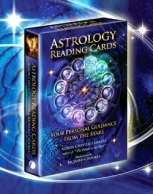


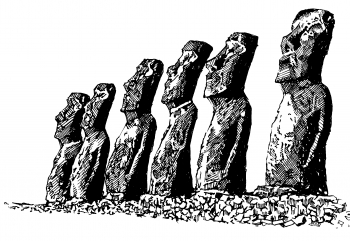 that were carved out of volcanic rock with little stone picks. They weighed from 20 to 270 tons and would have presented a greater challenge to the Islanders than the pyramids did to the Egyptians.
that were carved out of volcanic rock with little stone picks. They weighed from 20 to 270 tons and would have presented a greater challenge to the Islanders than the pyramids did to the Egyptians. 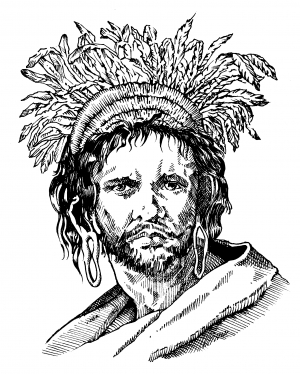 Before the European arrivals in the 17th or 18th century there were 6 or 7 main tribes or clans on the Island and it is quite obvious that these early settlers were a resourceful and clever people, deeply respectful of Mother Earth, the spirits and their ancestral inheritance. Their tribal way of life, competitive as it may have been, gave them something to be part of, they had a place, knew who they were and accepted both.
Before the European arrivals in the 17th or 18th century there were 6 or 7 main tribes or clans on the Island and it is quite obvious that these early settlers were a resourceful and clever people, deeply respectful of Mother Earth, the spirits and their ancestral inheritance. Their tribal way of life, competitive as it may have been, gave them something to be part of, they had a place, knew who they were and accepted both. 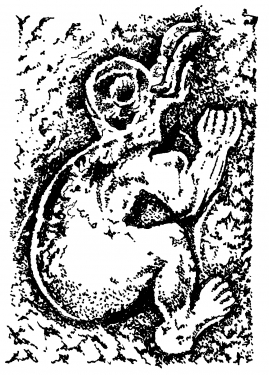 seabird returned to breed. Islanders would go to Orongo and reside in special houses built for the festival, waiting for the arrival of the seabirds who came to lay their eggs on an off shore islet. As the race began, many of the island men would climb down a steep high cliff, swim the dangerous sea on a little raft made of reeds, climb up onto the rocky islet, collect an egg, and finally carry it back unbroken. Thomson wrote:
seabird returned to breed. Islanders would go to Orongo and reside in special houses built for the festival, waiting for the arrival of the seabirds who came to lay their eggs on an off shore islet. As the race began, many of the island men would climb down a steep high cliff, swim the dangerous sea on a little raft made of reeds, climb up onto the rocky islet, collect an egg, and finally carry it back unbroken. Thomson wrote: 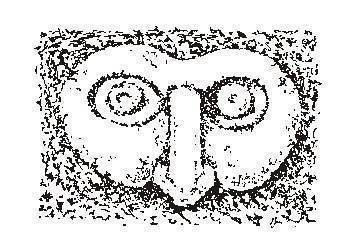 Makemake morphed into a Billy Connolly of sexual innuendo and lascivious comment, which provided a distraction from the horror and carnage of the European arrivals and perhaps also a useful impetus to support procreation to replace the lost population. The Island rock art became obsessed with symbols of the female vulva and Makemake`s early ethereal image morphed into a mask that had a phallus for a nose.
Makemake morphed into a Billy Connolly of sexual innuendo and lascivious comment, which provided a distraction from the horror and carnage of the European arrivals and perhaps also a useful impetus to support procreation to replace the lost population. The Island rock art became obsessed with symbols of the female vulva and Makemake`s early ethereal image morphed into a mask that had a phallus for a nose.



